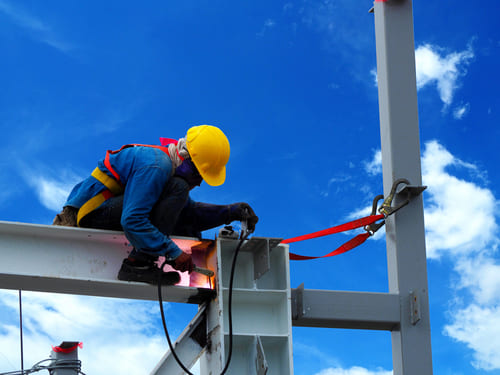Risk of work injuries not only substantially increase during the winter months, but work injury severity increases as temperatures drop. With over 20,000 work injuries in 2017, numbers from the U.S. Bureau of Labor Statistics (BLS) significantly support the elevated workplace risk during winter. Common winter hazards at the workplace include driving in the snow, working in slippery conditions, cold stress, and falling ice from rooftops. Outdoor workers face an increased risk of dangers from winter hazards, including slip and fall accidents, cold stress, and frostbite injuries.
Increase Awareness to Avoid Work Injuries
When the winter months arrive, all employees should have increased awareness during work hours. Whether you work in an office or an outdoor setting, slip and fall accidents are a leading contributor to work injuries. Slip and falls can occur not only during work hours but also while entering or leaving a job. “Slips, trips and falls account for 20 percent of all workplace injuries. In addition, slip and falls make up 15 percent of all accidental deaths, second only to motor vehicle accidents,” according to the Occupational Safety and Health Administration (OSHA). Outdoor workers need to be especially cautious, including jobs in construction, agriculture, fishing, recreation, first response, and snow removal. Outdoor jobs contend with the increased chance of slip or fall and automobile accidents caused by winter conditions. Also their frequent exposure to lower temperatures can cause serious cold-related illnesses and injuries. These types of injuries can lead to permanent tissue damage or even death.

Preparation for Winter Conditions
With proper preparation, awareness, and precautions, you can avoid a majority of injuries and illnesses caused by winter conditions. The goal is to create a workplace culture that identifies and addresses cold-related workplace hazards. You can discuss the plan for snow and ice removal from walking surfaces with your employers. For working outdoors, you can also try to reduce the time you are exposed to freezing temperatures. Work during the warmest parts of the day. Take advantage of staff rotations to limit the period of time outdoors. Below is a listing of common winter hazards and tips for avoiding work injuries caused by that specific hazard.
Winter Driving
- Practice safe driving behavior year round but also recognize the hazards of winter weather driving, such as snow or ice covered roads.
- Take advantage of training sessions on driving safely in winter weather conditions.
- Inspect all vehicle systems to ensure your vehicle is well maintained and operating properly prior to driving. Some vehicle areas to inspect include brakes, cooling system, battery, engine, exhaust system, tires, engine fluids, exterior lights, defrosters, and windshield wipers.
- Ensure an emergency kit is available in your vehicle. This kit should include an ice scraper, snow brush, flashlight, shovel, tow chain, traction aids, emergency flares, jumper cables, water, and blankets.

Walking on Snow and Ice
- Clear walking surfaces of snow and ice immediately after a winter storm to prevent slips, trips, and falls.
- Wear proper footwear for walking on snow or ice when going to work in winter conditions. An example of winter safe foot gear is a pair of insulated and water resistant boots with quality rubber treads.
- Take short steps while walking at a slower pace.

Working Outdoors
- Avoid the potential of suffering exhaustion, dehydration, back injuries, or heart attacks by pacing your work and taking frequent breaks in warm areas because cold temperatures take a toll on your body.
- Ensure you are wearing clothes that increase your visibility since snowfall decreases visibility.
- If you are working near a driving path, properly set up work zones with the traffic controls identified by signs, cones, barrels, and barriers, which will protect workers from traveling vehicles more likely to lose control.
- Evaluate the worksite for potential hazards and plan how to work safely prior to working outside in winter conditions. Some unexpected weather hazards to identify include layers of ice that form, the structural security of a surface weighed down by snow, and areas of ice above the worksite with the potential to fall.
Have You Suffered Work Injuries?
If you have suffered a workplace injury, please reach out to our legal team at Spear Greenfield immediately. We offer a free initial consultation to learn more details about your workplace accident and discuss your legal options. This consultation does not carry any pressure or obligation, just information, so call Spear Greenfield today or complete the form fill to schedule your fee consultation!
Spear Greenfield BenefitsFree Consultation
Call or text (215) 985-2424 or complete a Free Case Evaluation form











